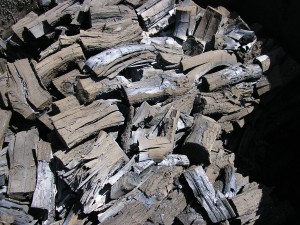Locally produced Charcoal
With the Summer weather improving there will be more opportunities to cook on a barbecue and dine with friends and family outside. You might not think that there could be many differences between brands of charcoal, but there are. In this post I will compare home produced from our native hardwoods with that from tropical hardwoods. Unfortunately, the UK still imports the majority of charcoal consumed annually. British hardwood charcoal is a higher quality and a better product than that produced from tropical hardwoods, and here are some reasons why:
Benefits
- There are far fewer impurities in the finished product so it will not taint the food being cooked. The same thing cannot be said for that produced from tropical hardwoods.
- It is easy to light with a taper of twisted paper, so does not need any lighter fluids or firelighters. When using lighter fluids or firelighters with charcoal, you will increase the chances of tainting any food being cooked from the extra residues.
- Charcoal made from UK hardwoods has a high carbon content. It will burn slower, you will use less, so it will last longer than tropical hardwood.
- UK production is often associated with sustainable forms of woodland management like coppicing. This type of woodland management enhances and maintains a diverse mix of wildlife habitats in our woodlands, thus keeping our woodlands healthy and thriving with wildlife. Whereas tropical hardwood charcoal often comes from rainforest and mangrove swamps, that use unsustainable and ecologically damaging harvesting practices in the form of deforestation.
- Buying British helps sustain rural employment. It is more environmentally friendly than imported charcoal that has to be shipped long distances using more fossil fuels in the process. Importing less will, in a small way, contribute to reducing our trade imbalances.
- Making it is a good method for using up small otherwise unusable pieces of wood by converting them into a higher value product.
Based on retail price British hardwood charcoal is more costly than imported tropical hardwood charcoal. However, comparing purely on price is not a fair comparison as I hope you will appreciate from the points mentioned above.
There are many smallscale producers all over the country. Some do supply big retail outlets directly, but be aware that big retailers squeeze producers in all sectors. So if you can, try and source either directly from the producer or from small local retail outlets and distributors selling their products.
